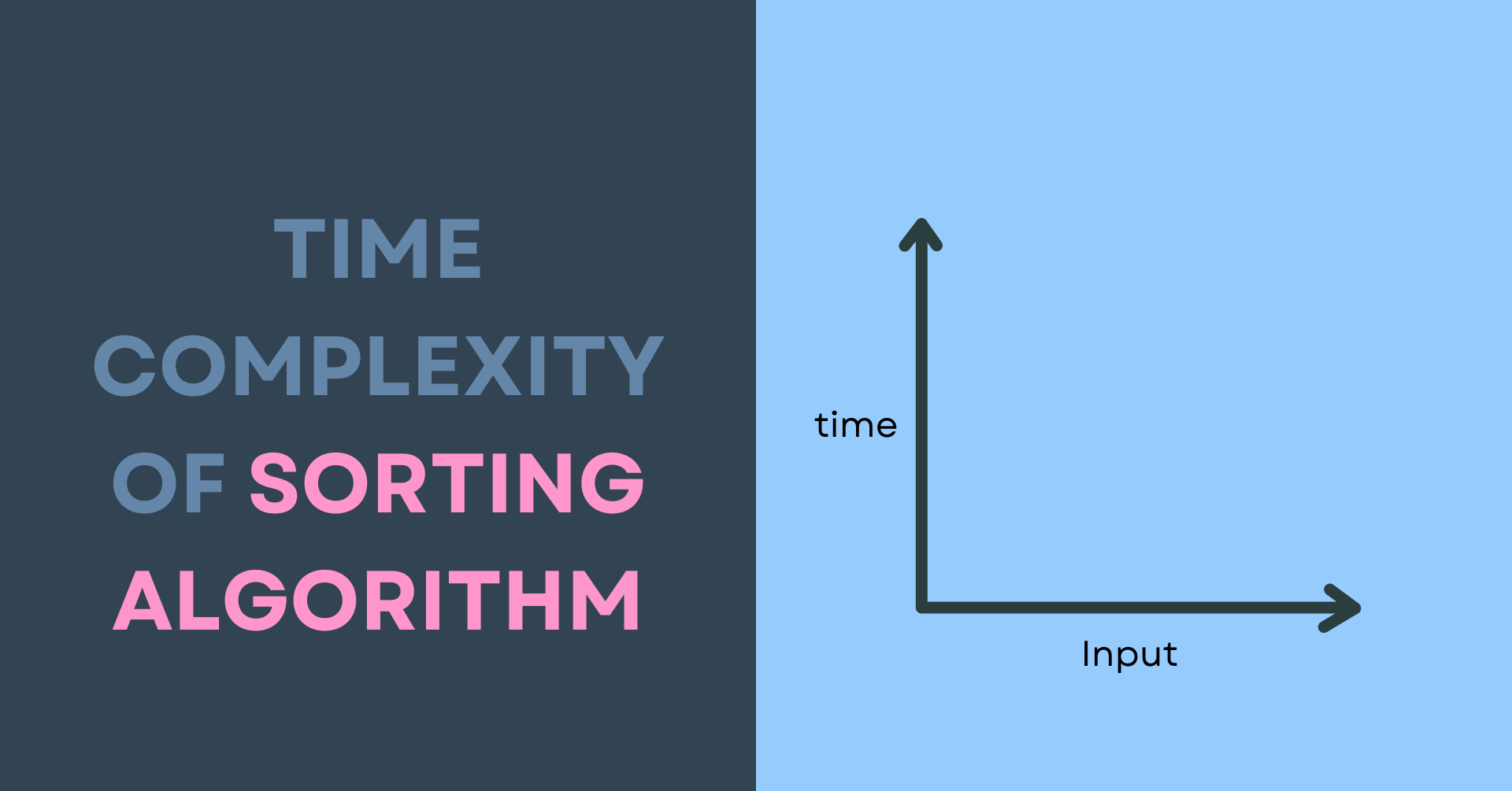Time Complexity of All Sorting Algorithms Explained Clearly
Sorting is one of the most essential concepts in computer science and
programming. Whether you're preparing for a coding interview, working on backend systems, or
taking an Algorithms Course in Noida, understanding sorting algorithms and their time complexity
is crucial.
If you're enrolled in an Algorithms Course in Noida or preparing for technical
interviews, this guide breaks down the time complexity of all sorting algorithms in a simple and
beginner-friendly manner.
1. What is Time Complexity?
Time complexity refers to the amount of time an algorithm takes to complete based
on the size of the input. It's commonly expressed using Big O notation, which provides a
high-level understanding of algorithm efficiency.
For sorting algorithms, we usually analyze:
- Best Case: The input is already sorted or in an ideal condition.
- Average Case: The input is randomly arranged.
- Worst Case: The input is in the most disordered state possible.
2. Bubble Sort
Bubble Sort is one of the simplest sorting algorithms. It works by repeatedly
swapping adjacent elements if they are in the wrong order.
- Best Case: O(n)
- Average Case: O(n²)
- Worst Case: O(n²)
- Space Complexity: O(1)
- Verdict: Easy to understand but inefficient for large datasets.
3. Selection Sort
Selection Sort repeatedly finds the minimum element from the unsorted part and
moves it to the front.
- Best Case: O(n²)
- Average Case: O(n²)
- Worst Case: O(n²)
- Space Complexity: O(1)
- Verdict: Performs well on small datasets, but time-consuming for large
inputs.
4. Insertion Sort
Insertion Sort builds the final sorted array one item at a time, like sorting a
hand of cards.
- Best Case: O(n)
- Average Case: O(n²)
- Worst Case: O(n²)
- Space Complexity: O(1)
- Verdict: Great for nearly sorted data and small datasets.
5. Merge Sort
Merge Sort uses the divide-and-conquer method. It divides the input into two
halves, recursively sorts them, and merges the sorted halves.
- Best Case: O(n log n)
- Average Case: O(n log n)
- Worst Case: O(n log n)
- Space Complexity: O(n)
- Verdict: Highly efficient, especially for large datasets. Extra memory
required.
6. Quick Sort
Quick Sort is also based on divide-and-conquer but selects a 'pivot' to partition
the array into smaller parts.
- Best Case: O(n log n)
- Average Case: O(n log n)
- Worst Case: O(n²)
- Space Complexity: O(log n)
- Verdict: Very fast in practice, but worst-case performance depends on
pivot selection.
7. Heap Sort
Heap Sort uses a binary heap structure to sort elements.
- Best Case: O(n log n)
- Average Case: O(n log n)
- Worst Case: O(n log n)
- Space Complexity: O(1)
- Verdict: Reliable and doesn't require extra memory.
8. Counting Sort
Counting Sort assumes that input elements are in a limited range. It counts the
number of elements and places them accordingly.
- Best Case: O(n + k)
- Average Case: O(n + k)
- Worst Case: O(n + k)
- Space Complexity: O(k)
- (k is the range of the input.)
- Verdict: Excellent for sorting integers with a small range, but not for
general-purpose sorting.
9. Radix Sort
Radix Sort processes numbers digit by digit. It’s a non-comparison-based sorting
algorithm.
- Best Case: O(nk)
- Average Case: O(nk)
- Worst Case: O(nk)
- Space Complexity: O(n + k)
- (k is the number of digits.)
- Verdict: Best suited for integers and strings with fixed lengths.
10. Bucket Sort
Bucket Sort distributes elements into buckets, sorts each bucket individually,
and then merges them.
- Best Case: O(n + k)
- Average Case: O(n + k)
- Worst Case: O(n²)
- Space Complexity: O(n)
- Verdict: Very efficient for uniformly distributed input.
11. Shell Sort
Shell Sort is a generalization of insertion sort that allows the exchange of
items far apart.
- Best Case: O(n log n)
- Average Case: Depends on gap sequence
- Worst Case: O(n²)
- Space Complexity: O(1)
- Verdict: Faster than insertion sort and bubble sort, especially for
medium-sized lists.
12. Time Complexity of All Sorting Algorithms
Below is a summary of the time and space complexities for various sorting
algorithms:
| Algorithm |
Best Case |
Average Case |
Worst Case |
Space Complexity |
Stable? |
| Bubble Sort |
O(n) |
O(n²) |
O(n²) |
O(1) |
Yes |
| Selection Sort |
O(n²) |
O(n²) |
O(n²) |
O(1) |
No |
| Insertion Sort |
O(n) |
O(n²) |
O(n²) |
O(1) |
Yes |
| Merge Sort |
O(n log n) |
O(n log n) |
O(n log n) |
O(n) |
Yes |
| Quick Sort |
O(n log n) |
O(n log n) |
O(n²) |
O(log n) |
No |
| Heap Sort |
O(n log n) |
O(n log n) |
O(n log n) |
O(1) |
No |
| Counting Sort |
O(n + k) |
O(n + k) |
O(n + k) |
O(k) |
Yes |
| Radix Sort |
O(nk) |
O(nk) |
O(nk) |
O(n + k) |
Yes |
| Bucket Sort |
O(n + k) |
O(n + k) |
O(n²) |
O(n) |
Yes |
| Shell Sort |
O(n log n) |
Varies |
O(n²) |
O(1) |
No |
13. How to Choose the Right Sorting Algorithm?
- For small inputs: Insertion sort or Bubble sort might work fine.
- For large and complex inputs: Use Merge sort or Quick sort.
- When space matters: Heap sort is efficient.
- When input is within a known range: Counting, Radix, or Bucket sort are
great options.
Understanding these trade-offs is something covered deeply in an Algorithms
Course in Noida, where real-life applications and optimization techniques are taught.
14. Real-World Applications of Sorting Algorithms
- E-Commerce Platforms (Amazon, Flipkart, Meesho)
- Use Case:
- Sorting products by price, ratings, discounts, or popularity.
- Organizing search results and filter options for better user experience.
- Common Algorithms:
- Quick Sort / Merge Sort: For efficient in-memory sorting of large lists.
- Tim Sort: Used in Python-based backend systems.
- Radix Sort / Counting Sort: For fast integer-based sorting (like price
filters).
- Why It Matters:
- Faster sorting means quicker response times for users, which translates into
higher sales and better UX.
- Banking and Financial Systems
- Use Case:
- Sorting transaction histories by date, amount, or type.
- Sorting customer records or loan applications for processing.
- Common Algorithms:
- Merge Sort: Especially useful for sorting linked data structures (like
transaction logs).
- Heap Sort: In-place sorting when memory is constrained.
- Why It Matters:
- Ensures fast retrieval and analysis of financial data, leading to better
decision-making and fraud detection.
- Data Analytics & Business Intelligence
- Use Case:
- Sorting data entries in spreadsheets, dashboards, or reports.
- Preparing datasets for aggregation, visualization, or machine learning.
- Common Algorithms:
- Tim Sort: Python’s pandas library uses it under the hood.
- Quick Sort: For internal fast sorting of numerical data.
- Why It Matters:
- Accurate sorting helps analysts derive meaningful insights from sorted
reports, such as top customers or peak sales periods.
- Telecommunication Systems
- Use Case:
- Sorting call logs by duration or timestamp.
- Organizing contact lists or SMS records.
- Common Algorithms:
- Insertion Sort: Efficient when logs are already mostly sorted.
- Merge Sort: For large-scale log processing.
- Why It Matters:
- Essential for maintaining organized logs, which helps in billing and user
behavior analysis.
- Social Media Platforms (Instagram, LinkedIn, Facebook)
- Use Case:
- Sorting posts by recency, likes, or relevance.
- Displaying friend suggestions or followers in order.
- Common Algorithms:
- Heap Sort / Quick Sort: Used in newsfeed ranking and trending content.
- Tim Sort: For user-level sorting features in mobile apps.
- Why It Matters:
- Enhances personalization and ensures users see the most relevant content
first.
15. FAQs: Time Complexity of Sorting Algorithms
- Q1. What is the fastest sorting algorithm in practice?
- Quick Sort is often the fastest due to its in-place sorting and cache-friendly
behavior.
- Q2. Which sorting algorithm is best for large datasets?
- Merge Sort and Heap Sort are preferred for their consistent time complexity.
- Q3. Why is Merge Sort preferred over Quick Sort in some cases?
- Because Merge Sort has a guaranteed O(n log n) time in all cases, unlike Quick Sort.
- Q4. Is there any sorting algorithm with linear time complexity?
- Yes, Counting Sort, Bucket Sort, and Radix Sort can achieve linear time under
certain conditions.
- Q5. What does it mean for a sorting algorithm to be stable?
- A stable sort maintains the relative order of equal elements.
- Q6. Which sorting algorithm uses the least memory?
- Heap Sort uses only O(1) auxiliary space.
16. Final Thoughts
Sorting algorithms are much more than textbook exercises. They form the
foundation of data processing and are used everywhere from search engines to e-commerce
platforms. Whether you’re learning them for interviews, projects, or academic purposes, knowing
the time complexity of all sorting algorithms helps you write better, faster, and smarter code.
To dive deeper and get hands-on practice, consider joining an Algorithms Course
in Noida, where you can learn these concepts from experts and apply them through real-world
projects.
Keep practicing, analyze the performance, and experiment with inputs of different
sizes. Sorting is your first step toward algorithmic excellence.


























